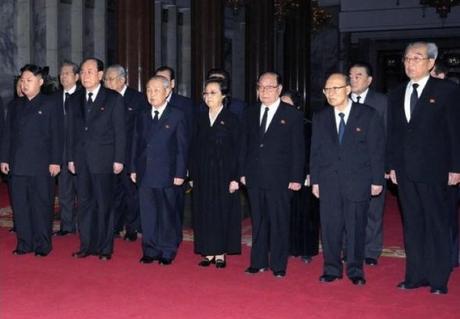
Kim Kuk T’ae (1924-2013) (Photo: Rodong Sinmun).

Kim Kuk Ta’e (2nd R) viewing the body of late DPRK leader Kim Jong Il in December 2011 (Photo: KCNA).
Kim Kuk T’ae, Chairman of the Korean Workers’ Party [KWP] Control Commission, died on 13 December (Friday) from congestive heart failure. Kim had been part of the DPRK leadership since for over five deacades and had close personal and political ties to late leader Kim Jong Il (Kim Cho’ng-il) and his sister KWP Secretary Kim Kyong Hui (Kim Kyo’ng-hu’i). At the time of his death, Kim was a member of the KWP Political Bureau, the KWP Central Committee and a deputy (delegate) to the Supreme People’s Assembly. According to KCNA, Kim “was a revolutionary soldier faithful to the WPK who dedicated his all to the triumphant advance of the revolutionary cause of Juche, true to the leadership of the party and the leader, the obituary said although he died, the exploits he performed for the cause of the party and revolution will be everlasting.” A national funeral committee was formed for Kim Kuk T’ae, who will receive a state funeral. On 15 December current DPRK leader Kim Jong Un (Kim Cho’ng-u’n) had a floral wreath sent “expressing deep condolences over his death.”
Kim’s career began in 1947 as an instructor in the local party apparatus. In 1956 he was appointed a section chief in the KWP Cadres Affairs Department and was promoted to deputy director of the department in 1961. In August 1963 he was appointed deputy director of the KPA General Political Department to 1968 he served as deputy director of the Korean People’s Army [KPA] General Political Department and was later appointed director of the Ministry of People’s Security Political Bureau where he played a leading role in consolidating Kim Il Sung’s (Kim Il-so’ng’s) political control over the KPA and the internal security apparatus. He was elected a member of the KWP Central Committee during the 2nd Party Conference in 1966. In 1967 he was appointed Director of the KWP Propaganda and Agitation Department where he worked closely with Kim Jong Il in establishing the monolithic leadership system and supervised a reorganization of the Party History Institute. In 1976 he was appointed President of the KIS Higher Party School, but Kim Kuk T’ae fell out of favor. He was transferred to the position of Chairman of the South Hamgyo’ng Provincial People’s Committee in 1977 and later the same year appointed DPRK Ambassador to Ethiopia.

Kim Kuk T’ae routinely accompanied Kim Jong Il during the late 1990s and early 2000s (Photos: Rodong Sinmun).
Kim Kuk T’ae returned to the DPRK from Ethiopia in July 1980. He appointed to work on the credentials and resolutions committees for the Sixth Party Congress held in October 1980. Kim was the main author of a number of documents relating to the party congress, including the party congress’ official report. During the early 1980s Kim was elected to a series of senior positions in the central party, being appointed director of the KWP Education Department (currently known as the KWP Science and Education Department) and director of the cadres’ training school in 1984 and being appointed director of the KWP Cadres’ Affairs Department in 1985. In 1990 Kim Kuk T’ae served as the President of the KIS Higher Party School and in 1992 he was appointed KWP Secretary of Cadres’ Affairs. In 1998 he served as a member of the Qualifications Screening Committee of the 10th Supreme People’s Assembly Kim served as the leading official of the KWP Cadres Affairs Department (which has personnel appointment and human resources functions in the party and government) from 1992 to 2010. Through the late 1990s to the early 2000s, Kim regularly accompanied Kim Jong Il at on-site appearances. On 28 September 2010 Kim Kuk T’ae was elected a full member of the KWP Political Bureau and appointed Chairman of the KWP Control Commission (which regulates the qualifications and status of party members), having been replaced as KWP Secretary and Director of Cadres Affairs. Kim Kuk T’ae remained a prominent elder member of the DPRK leadership, although he made most of his final public appearances during the summer of 2012.
Kim Kuk T’ae was born in 1924 in North Hamgyo’ng Province. He is the eldest son DPRK national hero Kim Ch’aek, who served with Kim Il Sung in the 88th Sniper Brigade in northeastern China during the 1930s and 1940s and who was later killed in action during the Fatherland Liberation (Korean) War. Kim Kuk T’ae was a member of the first class of the Mangyo’ngdae Revolutionary School and also attended KIS University, the Higher Party School and also studied in Russia. Kim Kuk T’ae received the Order of Kim Il Sung in 1982, as well as other state titles. Kim had three children, all of whom have worked in the party, government or security forces. His daughter Kim Mun Kyong (Kim Mun Kyo’ng) is currently a deputy director of the KWP International Affairs Department and served as a close aide and adviser to the late leader Kim Jong Il in the Personal Secretariat.
Kim was highly intelligent (“has the mind of a genius”),modest and preferred to keep a low profile in the DPRK’s political culture. The cardiac problems identified by DPRK state media as his cause of death began during the 1980s and he received medical treatment in China, Europe and the United States.
Filed under: Uncategorized
